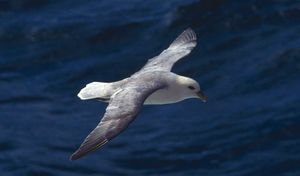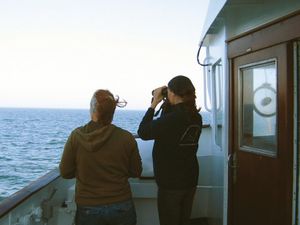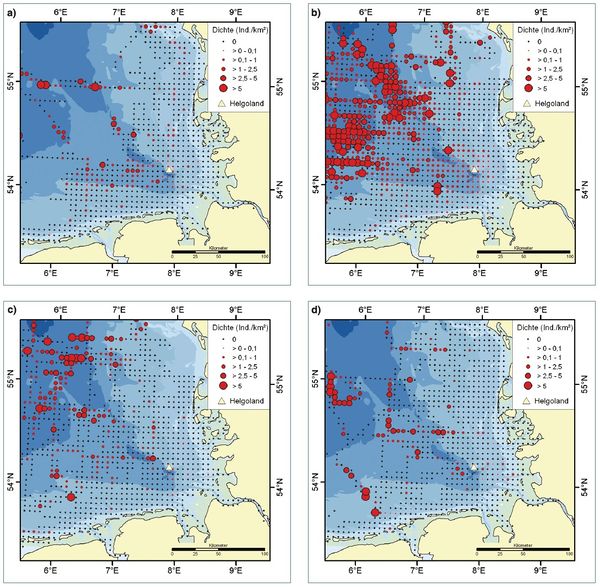Counting seabirds from ships and aircraft
Contents
Introduction
A few decades ago, knowledge about seabirds at sea was hardly available. In comparison, information on breeding ecology was more available, as brooding seabirds are easily to study. Systematic seabird surveys for the North Sea and the Baltic Sea have only been carried out during the last 2 or 3 decades. At present, studies for the German waters focus mainly on basic and applied research topics like functional relationships between the marine environment and seabird occurrence as well as their spatio-temporal dynamics. Applied approaches strongly increased with the first plans to set up offshore wind farms. The need to designate protected areas at sea, e.g. according to the EU Wild Birds Directive, as well as shipping traffic, fisheries and oil pollution, led to further data collections and analyses. In the meantime, surveying seabirds at sea became more and more part of national monitoring programmes. Here, we briefly describe the method used for counting seabirds at sea and illustrate results for one selected species, the Northern Fulmar (Fulmarus glacialis) (Fig. 1).
Counting methods from ships and aircraft
The common counting method for seabirds at sea from ships and aircraft is the counting along transects (Fig. 2). The transect width is 300 m for ship-based surveys and usually 397 m for aerial surveys. Since 1991 this method is the international standard for the north-east Atlantic region. For the two observation platforms, the transect strip is subdivided into bands which allow the later distance correction. The transects are set perpendicular to one or both sides of the ship/aircraft. All birds in the transect are counted and, if possible, are identified at species level. Additional information is, if possible, gathered on sex, age, and behaviour. During ship-based surveys, swimming and flying individuals are counted in different manners. Birds flying over the area of the transect strip are only counted at certain intervals, usually every full minute, thus the birds' move- ments are “frozen” and an overestimation of flying birds is avoided. Individuals crossing the transect strip during other times and outside the transect area are usually also recorded, but are not included in density calculations. During all surveys, geographical positions are recorded every minute on boats and every 5 seconds on aircraft.
Both methods have their advantages and disadvantages. Aerial surveys enable large coverage in a short time, with more or less constant environmental conditions, while these conditions may change more often during long ship-based surveys. In contrast, aerial surveys can only be conducted during calm conditions (max. 3-4 Bft). At higher seastates many birds remain unobserved. For some taxa species identification during aerial surveys is only possible to a very limited extent, e.g. divers, loons, auks, gulls and terns. For some species, aerial surveys provide better counting results. On the other hand, ship-based surveys allow much more detailed protocols, especially on bird behaviour, and hydrographic measurements can be carried out. The appropriate counting method depends largely on the study goals. Ideally the two methods are combined.Finding food is the main activity of all seabirds at sea. The foraging activities give information on the occurrence of birds in open waters and coastal areas and thus, particular attention is paid on the birds’ foraging behaviour during ship surveys. Most bird species in the German North Sea forage on, at or slightly below the water surface. Therefore, standard techniques for assessing food availability, such as hydroaccoustic surveys as they are used for fish, cannot be used for technical reasons. Instead, the foraging behaviour of seabirds gives often the only information on the marine and hydrographical processes which control the distribution of the birds at sea. They are ideally complemented by analyses of stomach contents and regurgitated food remains, obtained from other studies. Ship-based surveys are also appropriate to synoptical studies of the birds' habitats.
Results: the example of the Northern Fulmar
In Germany, the Northern Fulmar breeds only in a small colony on the island of Helgoland with about 100 breeding pairs but most individuals in German waters are non- breeders or originate from colonies in the U.K. or further north. However, the species is widespread at sea during all seasons. Total numbers in the German North Sea including the Exclusive Economic Zone (EEZ) and the territorial waters of the Federal States of Schleswig-Holstein and Niedersachsen have been estimated at 11,500 individuals in spring, 40,000 ind. in summer, 24,000 ind. in autumn and 10,500 ind. in winter (Garthe et al., 2007[1]). These changes in total numbers become even more visible in the maps for the German Bight (Fig. 3). Northern Fulmars are clearly more abundant in summer than in winter. The distribution of this species is closely linked to the Central North Sea Water while the Continental Coast Water is usually avoided (Garthe, 1997[2]; Markones, 2007[3]). The shown distribution is only an average with substantial variation, which is related to the hydrographic and meteorological regime.
See also
Internal links
References
- ↑ Garthe, S., Sonntag, N., Schwemmer, P. & Dierschke, V. (2007). Estimation of seabird numbers in the German North Sea throughout the annual cycle and their biogeographic importance. Vogelwelt, 128, 163-178.
- ↑ Garthe, S. (1997). Influence of hydrography, fishing activity and colony location on summer seabird distribution in the southeastern North Sea. ICES Journal of Marine Science, 54, 566-577.
- ↑ Markones, N. (2007). Habitat selection of seabirds in a highly dynamic coastal sea: temporal variation and influence of hydrographic features. Dissertation, University of Kiel.
Please note that others may also have edited the contents of this article.
|


